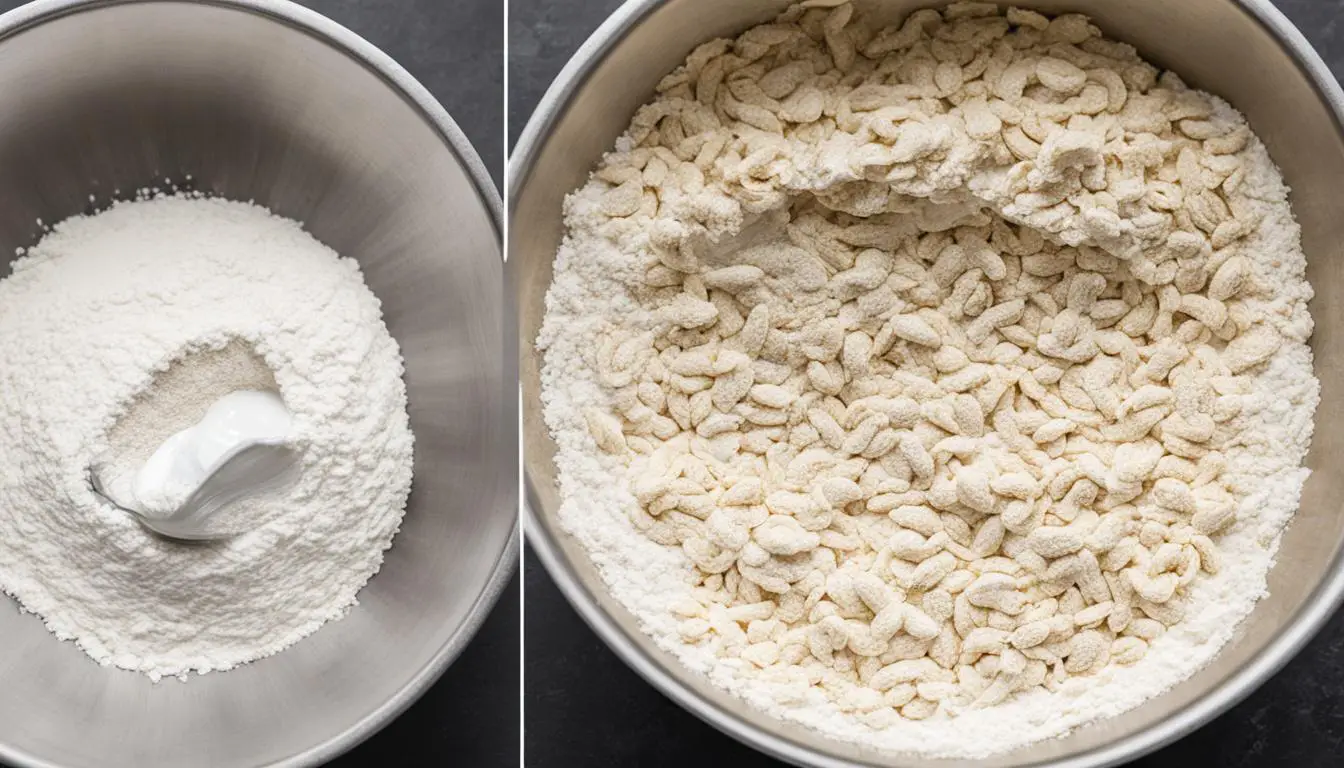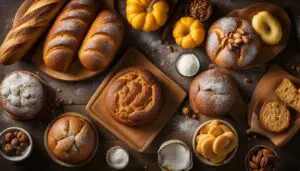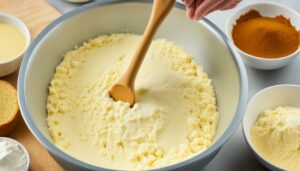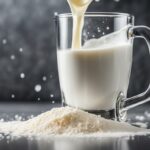Originally posted on January 9, 2024 @ 6:24 am
When it comes to baking bread, doubling a recipe can be a tempting idea. More delicious bread to enjoy and share, right? But what about the yeast – do you need to double it too?
Yeast, that tiny living organism responsible for the magical rise of bread, plays a crucial role in the fermentation process. It converts sugars and starches into carbon dioxide, alcohol, and natural acids, giving bread its fluffy texture and enticing aroma.
While it is generally recommended to double the amount of yeast when doubling a bread recipe, there are a few things to consider. Doubling the yeast can lead to rapid fermentation, resulting in an overly yeasty flavor and uneven rising.
Contents
- 1 Understanding Yeast and its Function in Bread Making
- 2 Types of Yeast and Their Properties
- 3 Doubling a Bread Recipe: The Mass Effect and Yeast Quantity
- 4 The Drawbacks of Adding More Yeast
- 5 The Importance of Proper Rising Times
- 6 Conclusion
- 7 Tips and Tricks for Working with Yeast
- 8 Additional Resources and Recipes
- 9 FAQ
- 9.1 Do I need to double the amount of yeast when doubling a bread recipe?
- 9.2 What is the function of yeast in bread making?
- 9.3 What are the different types of yeast?
- 9.4 How should yeast be stored?
- 9.5 Is there a concept called The Mass Effect in doubling bread recipes?
- 9.6 What are the drawbacks of adding more yeast to a bread recipe?
- 9.7 What is the purpose of the first and second rise in bread making?
- 9.8 Why is proper yeast quantity important in bread making?
- 9.9 What are some tips and tricks for working with yeast?
- 9.10 Where can I find additional resources and bread recipes?
- 10 Source Links
Key Takeaways:
- Yeast is a living organism that converts sugars and starches into carbon dioxide, alcohol, and natural acids through fermentation.
- Doubling the amount of yeast when doubling a bread recipe is generally recommended.
- Adding more yeast can lead to rapid fermentation and may result in an overly yeasty flavor and uneven rising.
Understanding Yeast and its Function in Bread Making

Yeast plays a crucial role in the bread-making process. It is a type of fungus that undergoes respiration and fermentation, producing carbon dioxide gas as a byproduct. When yeast is combined with flour and water, it converts the sugars present in the dough into CO2, alcohol, and natural acids. This process is known as the yeast fermentation process.
The carbon dioxide gas produced during fermentation gets trapped within the gluten structure of the dough. Gluten is a protein that gives bread its chewy texture and elasticity. The gas causes the dough to rise, resulting in light, airy bread. The gluten structure is like a network of elastic strands that expand as the gas is released, creating the desired texture.
The fermentation process is influenced by several factors, including the amount of sugars present in the dough, the temperature, the presence of salt, and the pH value. Different types of sugars can affect the rate of fermentation, while the temperature determines the speed at which yeast produces carbon dioxide. Salt can regulate yeast activity, and the pH value can affect the overall fermentation process.
If we take a closer look at the yeast and gluten structure, we can understand how they work together to create the perfect loaf of bread. This image illustrates how yeast interacts with gluten:
The Importance of Gluten in Bread Making:
Gluten is essential for bread-making, as it provides structure and elasticity to the dough. It is formed when two proteins within flour, glutenin and gliadin, combine with water. As the dough is kneaded, the proteins align and form a strong network that can trap and hold the carbon dioxide gas produced by yeast. This results in a well-risen and chewy bread texture.
The Fermentation Process:
During fermentation, yeast breaks down the sugars in the dough, releasing carbon dioxide gas. The gas bubbles get trapped in the gluten structure, causing the dough to rise. This process takes time and is influenced by various factors, such as temperature and sugar content. The longer the fermentation, the more flavors develop in the bread.
Factors Affecting Yeast Fermentation:
The fermentation process can be influenced by several factors:
- Sugars: Different types of sugars, such as sucrose, glucose, and fructose, can affect the rate at which yeast ferments. Yeast prefers simple sugars, like glucose, which are easily broken down.
- Temperature: Yeast is most active within a specific temperature range of 25-30°C (77-86°F). Higher temperatures can speed up fermentation, while lower temperatures can slow it down.
- Salt: Salt can regulate the activity of yeast. It helps control the fermentation process, preventing the dough from rising too quickly.
- pH Value: Yeast fermentation is optimal at a slightly acidic or neutral pH value. Acidity can affect the fermentation process, so it’s important to maintain the right pH balance in the dough.
Understanding the intricacies of yeast and its interaction with the gluten structure is essential for successful bread making. These factors play a significant role in achieving the desired rise, texture, and flavor in homemade bread.
Types of Yeast and Their Properties
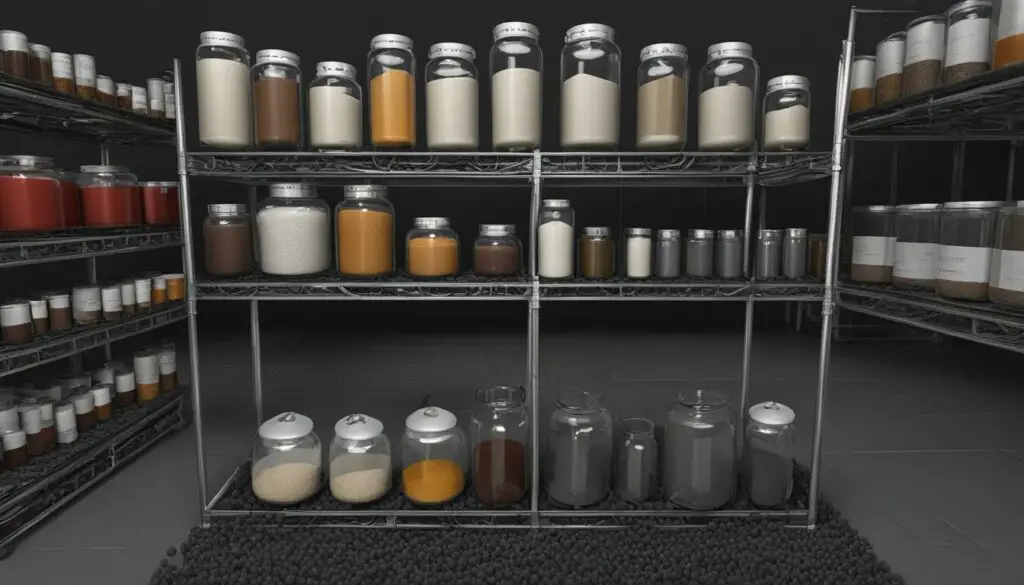
When it comes to baking bread, choosing the right type of yeast is essential. There are three main types of commercially available yeast: fresh yeast, active dry yeast, and instant yeast.
Fresh Yeast: Also known as cake yeast, fresh yeast is a moist and perishable form of yeast. It is typically sold in small cubes or blocks and requires refrigeration to maintain its freshness. Fresh yeast provides excellent leavening power and gives bread a light and airy texture. However, it does have a shorter shelf life compared to other types of yeast.
Active Dry Yeast: Active dry yeast is the most common type of yeast found in grocery stores. It is sold as small granules and needs to be bloomed or activated before use. To activate active dry yeast, it is first dissolved in warm water or milk with a small amount of sugar. This process allows the yeast to prove its viability and ensures proper fermentation in the dough. Active dry yeast has a longer shelf life than fresh yeast and is a popular choice among home bakers.
Instant Yeast: Also known as rapid-rise yeast or bread machine yeast, instant yeast is a finer form of yeast that can be directly mixed with dry ingredients. Unlike active dry yeast, there is no need to bloom or activate instant yeast before using it. Instant yeast dissolves quickly and activates rapidly, resulting in faster dough rising times. It is the preferred choice for many professional bakers and provides consistent results.
Proper storage of yeast is crucial to maintain its potency and extend its shelf life. Whether you have fresh yeast, active dry yeast, or instant yeast, storing it in the right conditions ensures optimal performance.
To store yeast:
- Refrigeration is necessary for fresh yeast, as it helps slow down its metabolism and maintain its freshness. Wrap the fresh yeast in plastic wrap or store it in an airtight container before placing it in the refrigerator.
- Active dry yeast and instant yeast can be stored in a cool, dry place, such as a pantry or kitchen cabinet. Keep them away from heat, moisture, and direct sunlight. Once opened, both types of yeast should be resealed tightly to prevent moisture absorption.
- For long-term storage, consider storing yeast in the freezer. Freezing yeast can significantly extend its shelf life. Transfer the yeast to an airtight container or freezer-safe bag before placing it in the freezer.
Remember to check the expiration date on the yeast packaging, as expired yeast may not provide optimal results in bread baking.
A Comparison of Different Types of Yeast
| Type of Yeast | Properties | Storage Requirements |
|---|---|---|
| Fresh Yeast (Cake Yeast) | Moist, provides excellent leavening power | Refrigerate, wrap tightly |
| Active Dry Yeast | Granules, needs activation before use | Store in a cool, dry place |
| Instant Yeast (Bread Machine Yeast) | Finer, no activation required | Store in a cool, dry place |
Understanding the different types of yeast and their properties allows you to choose the right yeast for your bread recipes. Whether you opt for fresh yeast, active dry yeast, or instant yeast, proper storage and handling ensure that your yeast remains fresh and active, resulting in delicious, homemade bread every time.
Doubling a Bread Recipe: The Mass Effect and Yeast Quantity
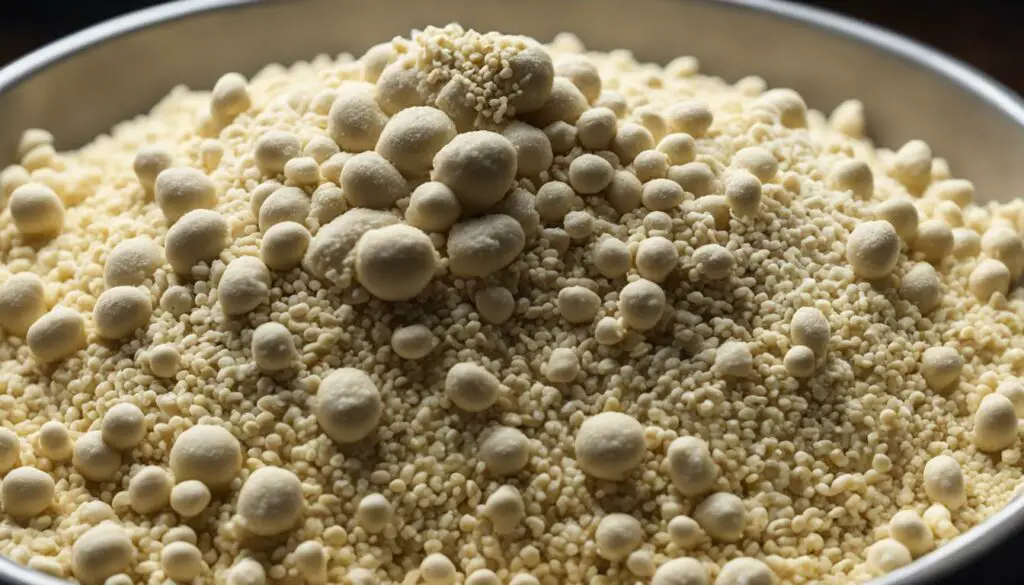
When it comes to doubling a bread recipe, it’s important to consider the quantity of yeast used. To maintain the proper fermentation and rise, it’s recommended to double the amount of yeast along with the other ingredients. However, it’s worth exploring the concept of The Mass Effect and its influence on dough rising.
The Mass Effect suggests that larger batches of dough may rise more quickly than smaller ones. This is because the increased amount of dough provides more food for the yeast to feed on, resulting in a quicker rise. However, it’s essential to note that this effect is not significant when working with minor changes in recipe quantities. In most scenarios, it can be ignored.
The rise of the bread is influenced by various factors, including the time it takes for the yeast to ferment and produce carbon dioxide gas, the temperature of the dough, and the activity of the yeast itself. While increasing the yeast quantity plays a role in the rise, maintaining a delicate balance of these factors is crucial for achieving optimal results.
By understanding the nuances of yeast and its interaction with the dough, bakers can achieve visually appealing and flavorful loaves of bread. The next sections will explore the drawbacks of adding more yeast and the importance of proper rising times in bread making.
The Mass Effect in Dough Rising
When working with larger batches of dough, some bakers may notice that the dough rises faster compared to smaller quantities. This phenomenon, known as The Mass Effect, is attributed to the increased food supply for the yeast in larger dough batches. The yeast has more sugars and starches to convert into carbon dioxide, resulting in a quicker rise.
However, it’s essential to remember that this effect is not significant when doubling a bread recipe. The minor increase in dough mass is unlikely to have a noticeable impact on the rising time. Instead, the rise of the bread is primarily influenced by the balance between yeast activity, fermentation time, and dough temperature.
While understanding The Mass Effect can provide valuable insights into dough rising, it’s important to focus on maintaining the proper yeast quantity and considering other factors that affect the rise. Proper fermentation time and temperature, as well as the overall consistency of the dough, play crucial roles in achieving the desired outcome.
| Dough Quantity | Rising Time |
|---|---|
| Small batch | Approximately 1-2 hours |
| Large batch | Approximately 2-3 hours |
As shown in the table above, doubling the dough quantity may result in a slightly longer rising time. However, the impact is minimal and can be easily managed by adjusting the fermentation time or temperature to ensure proper dough development.
Factors Affecting Dough Rising
In addition to yeast quantity, there are several other factors that can influence the rise of the dough:
- Fermentation Time: The amount of time the dough is allowed to rest and ferment affects the rise. Longer fermentation times can result in a more flavorful bread with a stronger structure.
- Dough Temperature: Yeast activity is temperature-dependent. Warmer temperatures accelerate fermentation, while cooler temperatures slow it down. Finding the optimal temperature for your specific dough and yeast is key.
- Dough Consistency: The proper hydration of the dough and the gluten development play crucial roles in achieving an optimal rise. Properly developed gluten provides the structure for the carbon dioxide gas to be trapped during fermentation.
By understanding and managing these factors, bakers can fine-tune their bread recipes to achieve consistent and satisfying results, regardless of the quantity of dough being prepared.
The Drawbacks of Adding More Yeast
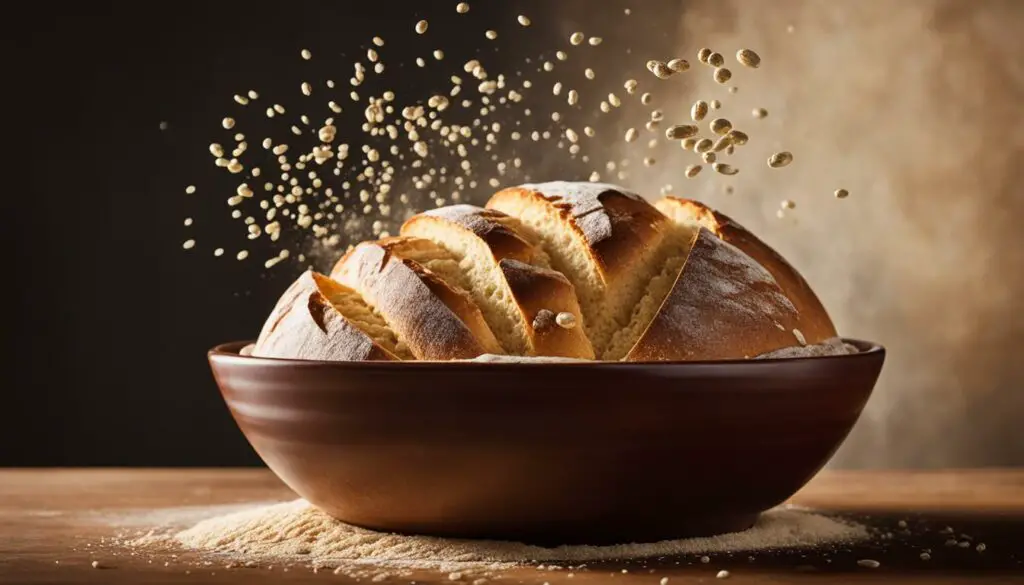
While increasing the amount of yeast in a bread recipe may seem like a solution to achieve a faster rise, it can actually have several negative effects on the final product. Let’s explore the drawbacks of excessive yeast in a bread recipe and its impact on dough consistency.
Excessive Yeast and Rapid Fermentation
When you add an excessive amount of yeast to your bread recipe, it can lead to rapid fermentation. Rapid fermentation occurs when the yeast converts sugars into carbon dioxide too quickly, causing the dough to rise rapidly. This rapid rise can result in an over-fermented dough that loses its structure and becomes sticky. As a result, the dough may lose its shape during baking and lead to a denser, less airy texture in the final bread.
Furthermore, when yeast ferments rapidly, it consumes sugars more quickly. This can leave the dough with insufficient sugars to feed the yeast during the entire fermentation process. As a result, the bread may have a yeasty flavor that dominates the taste, overpowering the other flavors and nuances of the bread.
Impact on Dough Consistency
Adding excessive yeast to a bread recipe can also have a significant impact on the consistency of the dough. The increased fermentation activity can make the dough excessively sticky and difficult to handle. It may become challenging to shape the dough into the desired form, as it tends to become too soft and slack.
Additionally, the excessive fermentation caused by too much yeast can lead to a coarser texture in the bread. The gluten structure may become weakened, resulting in a less elastic and more crumbly dough. This can affect the overall texture and mouthfeel of the bread, making it less enjoyable to eat.
To achieve the desired rise and flavor in your bread, it’s important to maintain a balance in yeast quantity. While it’s tempting to speed up the fermentation process by adding more yeast, it’s crucial to consider the potential drawbacks and find the optimal yeast quantity that provides a balanced rise and flavor.
By understanding the impact of excessive yeast on rapid fermentation and dough consistency, you can make informed decisions in your bread baking process and create delicious, well-textured loaves of bread.
The Importance of Proper Rising Times
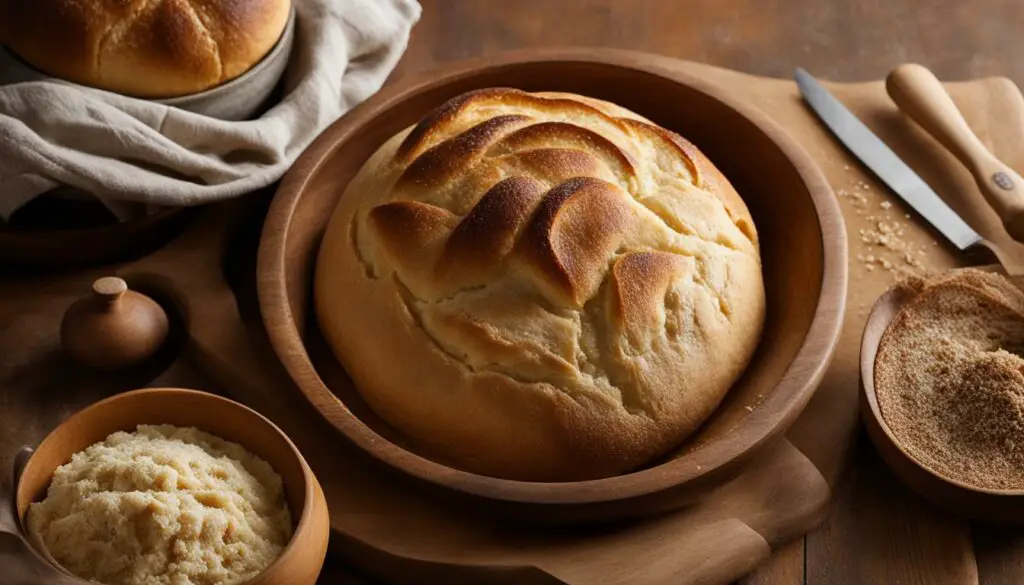
Bread recipes often include a two-step rising process: the first rise, also known as bulk fermentation, and the second rise, or proofing. Each rise has a distinct purpose in bread making, contributing to the overall texture and taste of the bread. Let’s explore the significance of these rising times and how they enhance the quality of your homemade loaves.
The First Rise: Bulk Fermentation
The first rise, or bulk fermentation, is a crucial step in bread making. During this stage, the dough undergoes long fermentation, allowing the flavors to develop and intensify. Bulk fermentation also allows the gluten structure to strengthen, resulting in a better texture and structure in the final bread.
For the first rise, the dough is typically covered and left to rest at room temperature for a specific period. The duration of bulk fermentation can vary depending on the recipe and ambient temperature. Generally, it ranges from 1 to 3 hours, but some recipes may require longer rising times for more complex flavors.
The Second Rise: Proofing
After the dough has undergone bulk fermentation, it is time for the second rise, known as proofing. Proofing is the final stage of bread rising, where the dough is shaped into its desired form, such as a loaf or rolls, and allowed to rise one more time before baking.
During proofing, the dough undergoes a shorter fermentation period compared to bulk fermentation. This rise is essential for proper aeration of the dough, which helps create a light and airy texture in the final bread. Proofing also allows the yeast to continue working, leading to additional flavor development.
The duration of proofing can vary depending on the recipe and the desired outcome. It usually ranges from 30 minutes to 2 hours, depending on factors such as dough temperature, yeast activity, and the desired level of dough expansion.
Optimizing Rising Times: Factors to Consider
Several factors influence the rising times during bulk fermentation and proofing. These include:
- Temperature: Yeast activity is influenced by temperature, with warmer temperatures accelerating fermentation. Higher temperatures can result in faster rising times, while cooler temperatures slow down the process. It is essential to follow the recipe’s recommended temperature guidelines for optimal results.
- Yeast Activity: The vitality of the yeast used in the bread recipe affects the rising times. Fresh and active yeast will ferment the dough more quickly, while weaker or older yeast may require longer rising times.
- Dough Consistency: The dough’s hydration level and gluten development affect fermentation and rising. A dough with higher hydration or well-developed gluten structure ferments faster than a stiff or less-developed dough.
By considering these factors and understanding the purpose of each rise, you can effectively manage rising times and achieve the desired texture, flavor, and volume in your homemade bread.
Final Thoughts
The proper rising times during bulk fermentation and proofing play a vital role in bread making. The first rise allows the dough to develop flavor and strengthen, while the second rise ensures proper aeration and final volume. By following the recommended rising times and considering the relevant factors, you can create delicious, well-risen bread that will satisfy your taste buds and impress your family and friends.
Conclusion
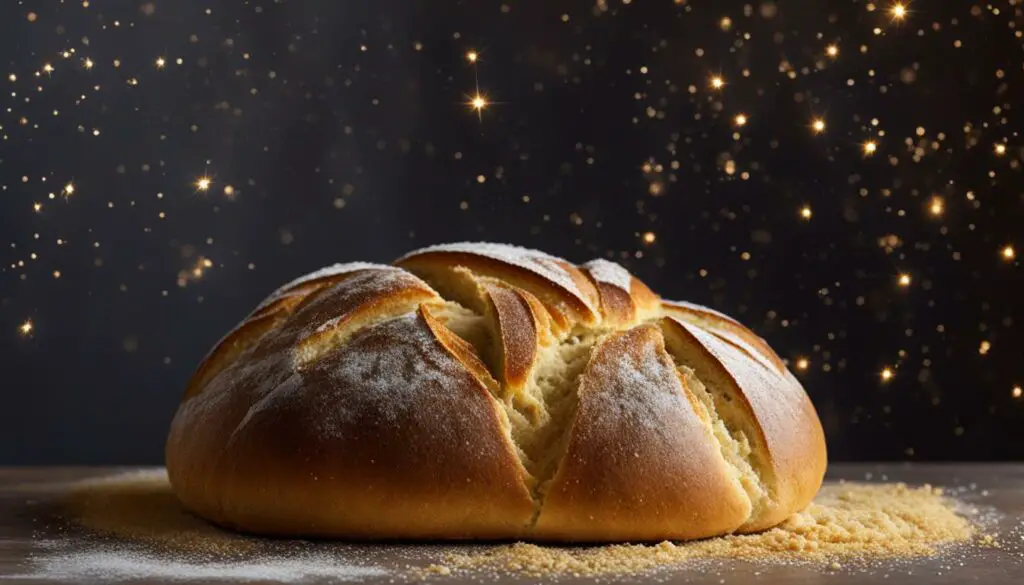
To achieve visually appealing and flavorful loaves of bread, it is recommended to double the amount of yeast when doubling a bread recipe. Understanding the nuances of yeast and fermentation is crucial in achieving the desired rise and texture in your bread. However, it is important to balance yeast quantity with other factors such as time, temperature, and dough consistency to ensure optimal results.
By doubling the yeast in your bread recipe, you ensure proper fermentation, allowing the dough to rise evenly and create a light and airy texture. However, it is important to be mindful of the potential drawbacks of adding more yeast, such as excessive fermentation and an overly yeasty flavor. Finding the right balance is key to achieving the perfect loaf.
Remember to consider other elements of the bread-making process, such as the rising times and the type of yeast being used. Different types of yeast require different handling methods, and understanding these variations can further enhance the quality of your bread.
So next time you’re doubling a bread recipe, make sure to adjust the yeast quantity accordingly. Keeping a close eye on all the elements of the bread-making process will help you create delicious homemade bread that will impress your family and friends.
Now that you have a better understanding of yeast and its role in bread making, you’re ready to embark on your bread baking journey. Remember to experiment, have fun, and enjoy the process. Happy baking!
Tips and Tricks for Working with Yeast
When it comes to baking bread, understanding how to work with yeast is crucial for achieving the perfect rise and flavor. Here are some tips and tricks to help you become a yeast expert in the kitchen.
Storing Yeast
Properly storing yeast is essential to maintain its potency and effectiveness. It is recommended to store yeast in airtight containers, either in the freezer or refrigerator. This helps to prolong its shelf life and ensure that it remains active when you’re ready to use it.
Yeast Substitution
There may be instances where you need to substitute one type of yeast for another. While it’s best to follow a recipe’s specific instructions, it is possible to make substitutions with slight adjustments in quantity. For example, if a recipe calls for instant yeast but you only have active dry yeast, you can use the same amount of active dry yeast, but you’ll need to activate it first. Keep in mind that different types of yeast may have varying potency, so it’s always a good idea to double-check ratios and make adjustments accordingly.
Yeast Activation
Depending on the type of yeast you are using, different activation methods may be required. For instance, active dry yeast needs to be bloomed before adding it to the dough. To do this, dissolve the yeast in warm water with a small amount of sugar and allow it to sit for a few minutes until it becomes foamy. This step ensures that the yeast is alive and ready to do its job, resulting in a well-risen and flavorful bread.
Experimenting with yeast ratios and rising times can also help you achieve the desired flavors and textures in your bread recipes. Don’t be afraid to try different approaches and techniques to find what works best for you. Happy baking!
| Tips and Tricks for Working with Yeast |
|---|
| Store yeast in airtight containers in the freezer or refrigerator. |
| Substitute one type of yeast for another with slight adjustments in quantity. |
| Activate active dry yeast by blooming it in warm water before adding to the dough. |
| Experiment with yeast ratios and rising times to achieve desired flavors and textures. |
Additional Resources and Recipes
If you’re eager to dive deeper into the world of bread baking, we have compiled some additional resources and recipes to enhance your baking skills. These sources provide valuable information on working with yeast and offer a wide range of delicious bread recipes to try.
Bread Baking Tips:
- Use a kitchen scale to measure ingredients accurately, especially when working with yeast. This ensures consistent results in your bread.
- Knead the dough sufficiently to develop gluten, which gives bread its structure and texture.
- Give your dough ample time to rise, following the recipe’s instructions. This allows the yeast to ferment and create carbon dioxide gas, resulting in a light and airy loaf.
Yeast Bread Recipes to Try:
- Classic French Baguette: Indulge in the crisp crust and soft interior of this iconic bread.
- Whole Wheat Sandwich Loaf: Enjoy a healthier option without compromising on flavor.
- Cinnamon Swirl Bread: Wake up to a delightful breakfast treat with a sweet cinnamon filling.
- Garlic and Herb Focaccia: Elevate your meals with this flavorful Italian bread topped with aromatic herbs.
For more detailed bread baking tips and mouthwatering recipes, check out the following resources:
- King Arthur Baking
- The Spruce Eats
- Baking Sense
Embark on your bread baking journey with confidence, armed with these valuable resources and delectable recipes. Enjoy the process of kneading, proofing, and devouring your homemade bread creations!
FAQ
Do I need to double the amount of yeast when doubling a bread recipe?
Yes, it is recommended to double the amount of yeast used when doubling a bread recipe.
What is the function of yeast in bread making?
Yeast is a living organism that converts sugars and starches into CO2, alcohol, and natural acids through fermentation, causing the dough to rise.
What are the different types of yeast?
There are three main types of commercially available yeast: fresh yeast, active dry yeast, and instant yeast.
How should yeast be stored?
Yeast should be stored in an airtight container in either the refrigerator or freezer to maintain its potency.
Is there a concept called The Mass Effect in doubling bread recipes?
While The Mass Effect suggests that larger batches of dough rise faster than smaller ones, the impact is not significant when working with minor changes and can often be ignored.
What are the drawbacks of adding more yeast to a bread recipe?
Adding more yeast can lead to excessive fermentation, resulting in an overly yeasty flavor, uneven rising, and a coarser texture.
What is the purpose of the first and second rise in bread making?
The first rise, also known as bulk fermentation, allows the dough to develop flavor and strengthen, while the second rise, or proofing, ensures proper aeration and final volume.
Why is proper yeast quantity important in bread making?
Maintaining the proper yeast quantity is crucial for achieving the desired rise and flavor in the bread.
What are some tips and tricks for working with yeast?
Properly storing yeast, understanding yeast activation methods, and experimenting with yeast ratios and rising times can help achieve desired flavors and textures in bread recipes.
Where can I find additional resources and bread recipes?
To further explore the world of bread baking, you can find additional resources and a variety of bread recipes to try.

